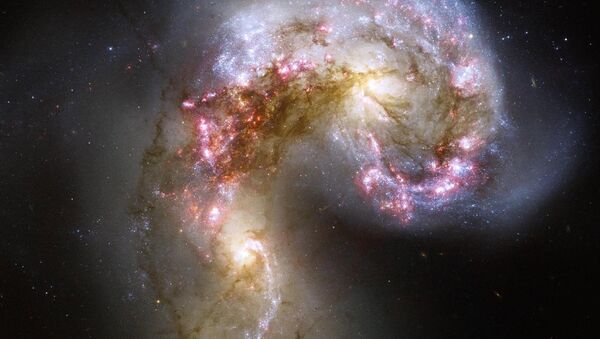These starburst galaxies produce stars at a rate of 100 solar masses every year. By comparison, the Milky Way produces an estimated four solar masses each year. This would be odd enough on its own, but the hyperactives have another strange quality: they're all old. Each of the starbursts came into existence less than a billion years after the Big Bang.
This could make starburst galaxies a major clue to one of astronomy's biggest mysteries: how could supermassive galaxies and black holes form in the early universe? Big things take time to form, but in a cosmic blink of an eye, these enormous objects appeared in the universe.
But if whatever is causing the starburst galaxies to grow so quickly was also present in the early universe, it may have been the cause of the rapid onset of massive galaxies. Giving credence to this theory is that the majority of starbursts discovered before were very far away from Earth, which means they were more prevalent in the early universe.
Nothing is set in stone, however. "Whether or not the fast-growing galaxies we discovered are indeed precursors of the massive galaxies first seen a few years back will require more work to see how common they actually are," said study contributor Eduardo Bañados from the Carnegie Institute in Pasadena, California.
The scientists discovered the galaxies by accident, while they were studying star formation by looking at quasars – supermassive black holes surrounded by accretion disks of matter. "We were looking for something different: for star formation activity in the host galaxies of quasars," said study lead Roberto Decarli, with the the Max Planck Institute for Astronomy (MPIA), in a statement.
"But what we found, in four separate cases, were neighboring galaxies that were forming stars at a furious pace, producing a hundred solar masses' worth of new stars per year."
Most starburst galaxies detected until now were in the process of merging with other neighboring galaxies, but this wasn't the case for the four discovered by Decarli's team. Instead, they believe the quasars at the centers of these galaxies to be the cause of their hyperactivity.
"Very likely it is not a coincidence to find these productive galaxies close to bright quasars. Quasars are thought to form in regions of the universe where the large-scale density of matter is much higher than average. Those same conditions should also be conducive to galaxies forming new stars at a greatly increased rate," said MPIA member and co-author Fabian Walter in the statement.




